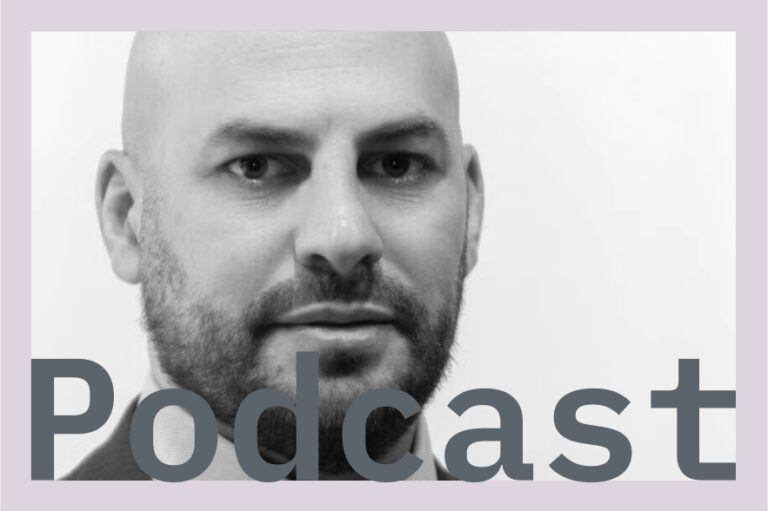
Four senior leaders of Deutsche Telekom’s world-class IT organisation reveal the three-year journey undertaken to deliver a new era of technical and cultural agility to Europe’s largest telecoms company.
At the beginning of 2017, Deutsche Telekom’s new corporate CIO, Peter Leukert, arrived and found an IT organisation bedevilled by inertia. Years of technological, cultural and procedural baggage was slowing it down.
The company was – and is – hugely successful: A $100 billion company, Europe’s largest telco, second-placed in the US (with not-unrealistic aspirations to soon be first), providing fixed lines, mobile, internet, IPTV and a suite of products and services to hundreds of millions of people and businesses in more than 50 countries. It’s also one of the world’s leading IT services providers.
Deutsche Telekom’s IT organisation sits under the Technology and Innovation remit at board level and is, by any measure, at the vanguard of the world’s transition to an anywhere-anytime gigabit society. And yet just two years ago it was taking 18 months or more to go to market with new IT products. And the people tasked with doing it – 10,000 elite-level technologists in Germany and across Europe, India, Russia and Brasil – felt disempowered; they were straightjacketed by technical legacy, longstanding and inflexible processes, rigid silos, and a towering hierarchy.
It was in those same people, however, that Leukert knew the solution lay. He began a rigorous process of honest reflection, led by a cross-sectional cohort of the company’s existing subject experts and leaders. The task was to identify all areas of a mission to entirely transform the IT organisation and put pace, agility and collaboration at its heart.
It would involve a root-and-branch examination of architecture, management structures and toolsets but, most critically, be underpinned by systematically nurturing a new culture of free and open communication, trust, and individual empowerment. A project of impressive ambition on both a technical and very human level, it involved input from across the entire organisation and was codenamed IT@Motion.
LEADERSHIP IN MOTION
For more than a decade, Deutsche Telekom has strived as a matter of policy to encourage diversity within its workforce. It has become a standard bearer in Germany and around the world for its conscientious effort to remove barriers to women’s access to technology careers, especially in terms of management roles. Technology and innovation at the group board level is overseen by former McKinsey technology chief and theoretical physicist Claudia Nemat, while half of the company’s Supervisory Board is now comprised of women. Four members of Deutsche Telekom IT’s own management board are women, and Leukert himself increased diversity as a key to unlocking successful culture change in times of transformation.
Deutsche Telekom’s remarkable transformation story is a tale ultimately written by all 10,000 members of its team. Its central plotline is their energetic willingness to embrace change, collaborate and learn. But it is four senior female leaders who help us lift the lid on the strategies and techniques that have made it all possible.
One of those is Katja Drechsler, who sits at the very epicentre of change as SVP IT Strategy and Transformation, CIO-Office. She took on the position in 2017 after a varied 17-year journey at the company that saw her start in a T-Mobile call centre before ascending to oversee customer service functions, information management, and outsourcing management. Her role now is to shape and communicate the transformation vision and foster continuous engagement with it.
“Deutsche Telekom is no longer only competing with other network providers. We’re also competitive with Amazon, Google and co for customer attention. New technology companies are dramatically shifting the benchmark in terms of development speed, customer experience and quality. That’s the reason we needed to move,” she explains.

She takes us back to the beginning – to the very first off-site meeting, in which systemic thinking was deployed to begin analysing all facets of their organisation’s character and to start charting the journey ahead.
“The hypotheses were on the wall and it was a silent walk around, in 30 or 45 minutes. And it was like going through a museum… you could feel the pain and the fear,” she recalls. “In all dimensions we needed a quantum leap.”
Those original hypotheses – 28 of them to be exact – helped compartmentalise the problems that needed to be solved and formed the outline of a conceptual architecture for transformation.
But in identifying the ballast that was weighing the organisation down – technical, procedural or human – it was clear that one factor was more fundamental than any other: Culture. Hundreds of staff interviews followed, confirming that what needed to be tackled was an embedded culture of over-cautiousness and fear. Along with a lot of technical debt, the cultural malaise had led to organisational silos, a lack of accountability and free collaboration, and a swollen, bureaucratic hierarchy of decision making.
Leukert says the “big idea” at Deutsche Telekom IT is to create a culture where “the big ideas come from great minds all over the organisation and not necessarily only from the top”. Mindset change, then, was to be the wellspring from which broader structural change would grow. Without it, transformation would simply not succeed.
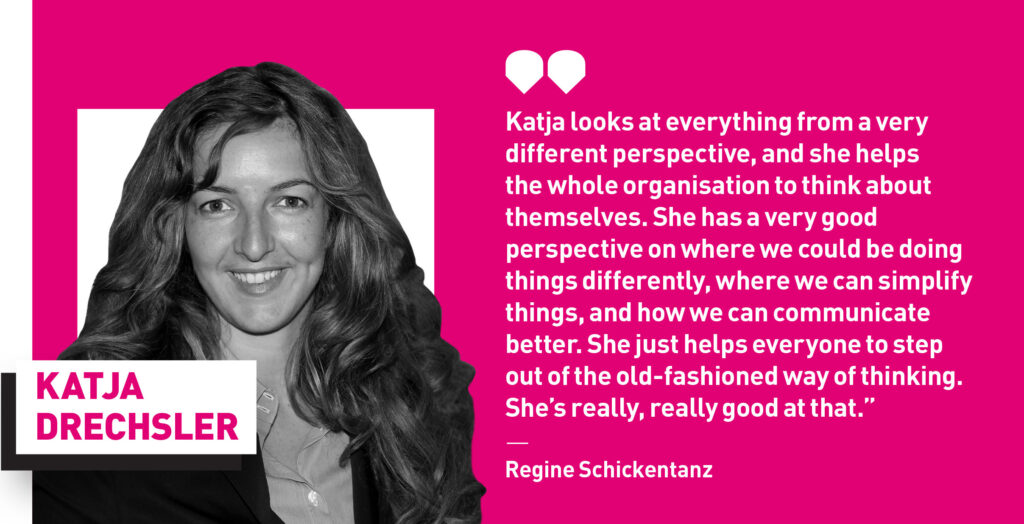
DIMENSIONS OF CHANGE
Drechsler explains that the transformation strategy was refined around five key pillars, the first being culture, along with architecture, operations, organisation, and delivery. “First of all it’s culture. We want to be fearless and transparent. Inside this culture is a relentless self-improvement and servant leadership behaviour,” she says.
“The second is architecture; it should be decoupled and flexible. The third is of course delivery, so based on a new way of working, from Tayloristic to agile. Then we have the fourth dimension around organisation: skill based… from a line organisation to responsible teams. And the fifth is of course operations – we want high quality stability for our customers and business partners.”
In ‘servant leadership’, Drechsler highlights a particularly important cornerstone of the Deutsche Telekom IT transformation strategy. Managers are actively coached and supported to systematically upend hierarchical management practices, instead working relentlessly to empower the people in their teams.

The culture shift was to be achieved simultaneously with the rollout of lighthouse projects. Here, new teams would be brought together from across the organisation – including in particular from non-IT parts of the business – to work together with an agile methodology largely new to the people involved. They would be supported structurally by the whole management team and a steering group known as the Plexus, a team drawn from across the organisation tasked with mirroring reality on the ground and catalysing continuous feedback. Meanwhile, a network of internal academies would foster continuous learning.
Sabine Abecker led the very first of what would ultimately become many distinct multifunctional teams assembled around specific projects, called Digital Hubs. Abecker has been building software and systems at Deutsche Telekom for more than 20 years and recognises more than most the seismic shift that has occurred within its walls over the last three.
“For me, it was in the beginning really a movement,” she says.
“Talking to the people without hierarchy, talking direct to them. In the beginning they were really astonished when management asked ‘normal’ experts for their opinion. They didn’t believe that their opinion was really asked for!”
Abecker led the formation of a team around a new product, at the time known as Magenta Haus. It was the first of many “greenfield” projects, defined as such because it was largely unencumbered by legacy technology and, indeed, expectations. The team scrummed within the Scaled Agile Framework (SAFe) and embraced from day one its critical tenets of pan-business engagement and continuous education.
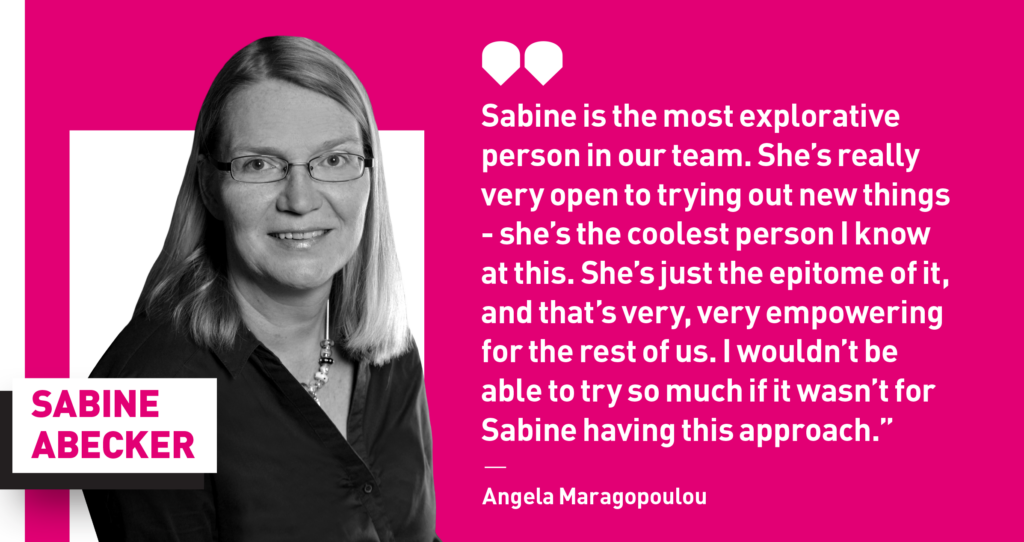
“We completely changed our collaboration with the people from the business side. Before, it was completely different, there was always a burden between the business side and IT, and here it’s all cross functional. We changed the technical architecture, we changed the business architecture, and we built a completely new customer care system,” she says.
“So in the end we changed nearly everything.”
Abecker now oversees 15 self-organising scrum teams leveraging at pace hitherto unfamiliar tools such as Kubernetes, MongoDB and a full adoption of cloud. COBOL, a programming language dating back to the 1950s, still exists at Deutsche Telekom – most large companies would actually admit to the same – but Abecker is leading the charge into the future.
Conventional management hierarchies have collapsed as part of that process and Abecker, like Drechsler and managers throughout the company, have learned the power of servant leadership in helping it to happen. Abecker’s self-sufficient agile teams no longer wait for cascading commands, but rather take guidance. She doesn’t prescribe actions, but rather describes outcomes focused on how she can help the individuals in her teams deliver them.
“I really have to fight against my own patterns. Not doing task lists, not doing command and control. But in Magenta Haus, they always give very quick feedback. ‘No, Sabine! You have not to tell us how to do this! So they also gave me the possibility to develop myself further.”
ARCHITECTING PACE
Self-reliant scrum teams, servant leaders, academies and holocratic management philosophies are all very well, but they’re nought without a technical architecture capable of moving at the same speed.
Chief Architect Regine Schickentanz has also spent 20 years at Deutsche Telekom, beginning as an R&D engineer before going on to manage a wide variety of major initiatives. She is now leading her teams of highly skilled technicians out of their traditional space, and out of their comfort zone.
“So we were very efficient, but in this journey of becoming more efficient and really getting stuck to all the very formal processes in that long waterfall, we forgot to be flexible for the business side. It is much easier to come to a good solution if you talk to each other,” she says.
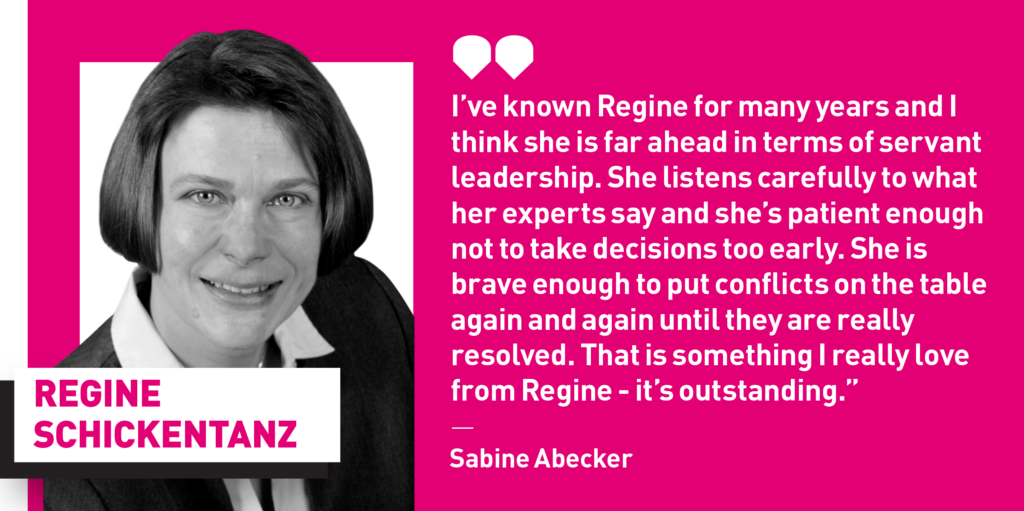
The biggest change for Schickentanz’s architects has been remoulding their day-to-day efforts as part of much broader teams. Projects are now managed in sprints including input from team members across the business – from sales and marketing through to network services, operations and top-level management.
“You can only change architecture if you do cross-functional collaboration,” she adds. “It’s a very mixed team we are working with, and I think this is one of the very important key factors that helps us to do the transformation. And this is also one of the big changes for most of the architects, to do this cross-functional interworking.”
Schickentanz is responsible for a foundational element of Deutsche Telekom IT’s overall transformation strategy – she is not only changing the way architects do their work, but in doing so is enabling the rest of the organisation to do the same.
“This is one of the really big cultural changes. You have to think of making smaller pieces; thinking in minimal viable products and not thinking I have to have a fully-fledged solution specified at the beginning of the process. Architecture was one of the topics that we had to think about because our classical IT chains were so tightly coupled that it is simply not possible to only go with smaller parts. Whenever you change a small part you have to have the whole chain retested,” she says.
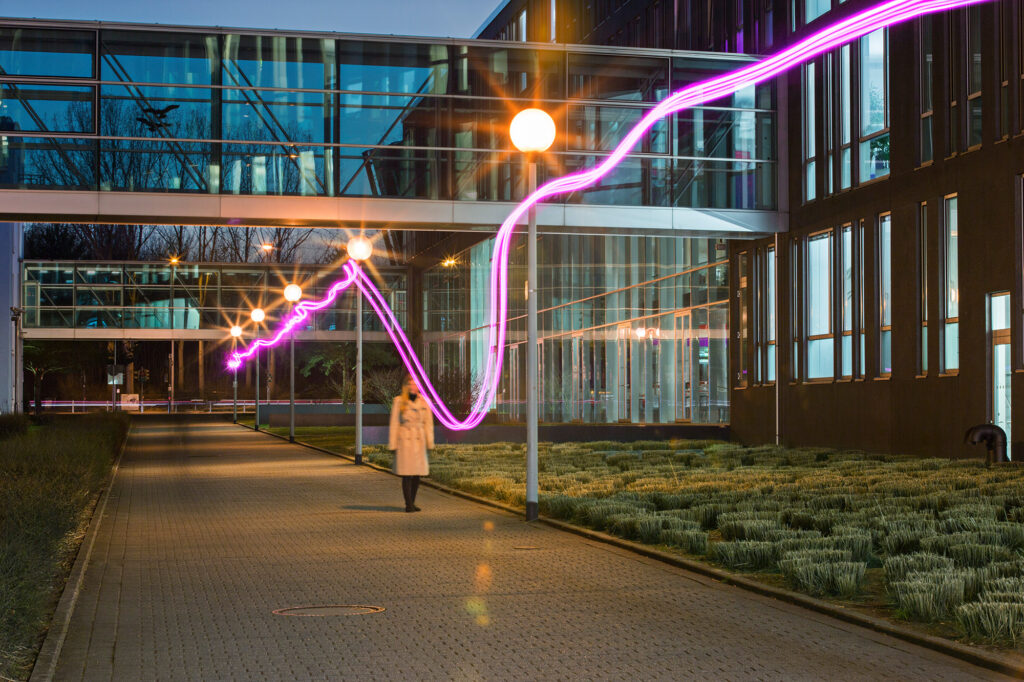
Architecture at Deutsche Telekom IT is transforming along four dimensions: Modernisation, Decoupling, Retirement and Selective Greenfield. Each dimension is communicated internally with its own unique colour coding, expressed in every document, presentation and working group. Thus, the inherent complexity of the architecture arena is broken down into Schickentanz’s ‘smaller pieces’ and becomes digestible by a greater variety of collaborating team members.
Where projects can be undertaken afresh without triggering a blast radius of technical consequences, it’s ring-fenced as ‘Greenfield’. Abecker’s trailblazing Magenta Haus was an early example, along with Deutsche Telekom’s enormous ongoing fibre roll-out, which has been built with an entirely new microservices-based IT architecture. Every document, application or microservice in those areas is coloured green.
Where forward progress is hindered by a legacy of IT dependencies, the need for decoupling actions are coloured yellow. Modernising IT infrastructure as a whole and retiring legacy systems are flavours of blue. Schickentanz cites the example of work undertaken to overhaul management of the company’s customer data, where huge, complex and critical applications have been replaced piece-by-piece, sprint-by-sprint with common APIs feeding much leaner applications.
And all the while, Schickentanz has learnt to support her teams not as a taskmaster, but as a servant leader active in the work itself, while operating as an evangelist throughout the organisation for the ‘big ideas’ her cross-functional teams produce.
MOVING AHEAD
Angela Maragopoulou has just celebrated her first year as SVP of Business Solutions in Deutsche Telekom’s B2B division. She joined to lead software delivery and operations in service of the company’s business customers and did so at the sharp end of the pan-organisational effort to redefine the role and culture of IT itself.
But Maragopoulou is no stranger to challenge and change – she studied both astrophysics and electronics before commencing her telecoms career “working with 174 men” as a field engineer. She’s since worked across a vast array of disciplines, from IoT to sales and marketing, and has relished the opportunity to link into an inspiring ongoing transformation journey at Deutsche Telekom.
“It’s looking very good. From the lighthouse perspective I have been very impressed with the outcomes,” she says. “I have not enjoyed this much trust in a corporate environment before. The trust levels of these teams are unique and I’m really happy I’m working with them.”
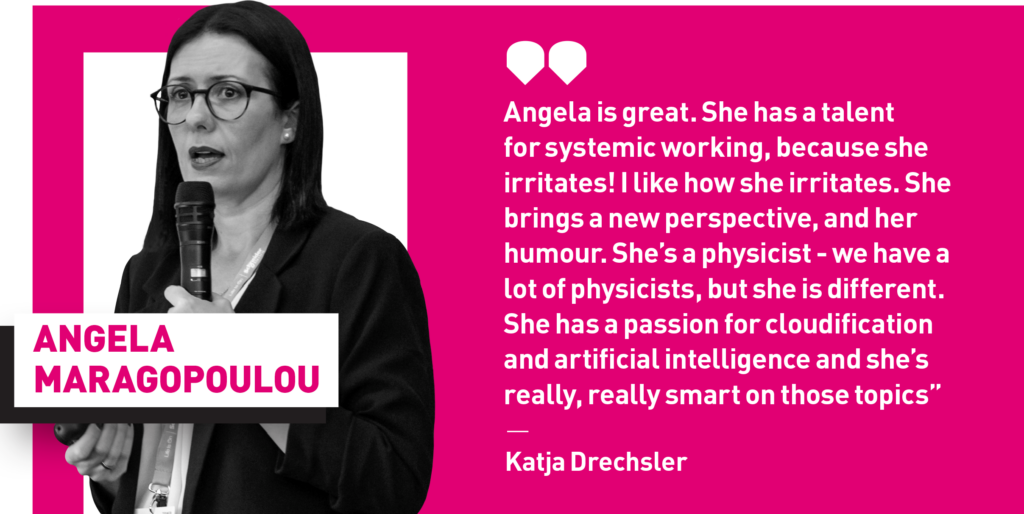
It’s that trust, built up over more than three years of reflection, education and collaboration, led by the likes of Drechsler, Abecker, Schickentanz and many others, that has allowed Deutsche Telekom to conquer its primary objective: The laborious 18-month time to market has now been reduced to as little as three.
And it’s trust that is enabling the company to continue to deliver on its transformation objectives, even during the colossal disruption of a global pandemic. The journey is far from complete, as Maragopoulou is quick to point out. In her own organisation, she is overseeing the work of Digital Hubs delivering software to the marketing, sales and service management areas of the business, while also sponsoring the company’s data strategy and a hub dedicated to AI. But the methodical, iterative process to incorporate areas of the business yet to be converted to the new ways is an ongoing process.
“It’s a continuous thing. The transformation does not have a beginning and a stop – it doesn’t have dates. It goes on and we change again, and then through that process you have a continuous communication effort,” she says.
A culture of confident teamwork has been ignited within Deutsche Telekom IT, enabling it to move faster and far more collaboratively with the rest of the business. That culture is one that also helps the organisation to navigate the inevitable headwinds of change as it counsels, coaches and upskills team members through altered circumstances. While they work to serve their own teams, Dreschler, Maragopoulou, Abecker and Schickentanz have also coordinated management discussion groups to ensure they themselves continually learn and improve.

“We are not finished I have to admit. There are still big areas where we have to do this change,” says Abecker. “Our people are high skilled, and they are able and want to learn their whole life. They will never stop learning – they will always want to learn.”
“You always have room for improvement,” agrees Schickentanz. “And it’s very important that you can’t do this on your own. This only works if you closely collaborate with the business side. We’ve never moved forward so well in changing the architecture and working together with the business side.”
Drechsler puts Deutsche Telekom IT’s continuing transformation success down to the willingness of the entire organisation to embrace change and act with a sense of fearlessness.
“IT@Motion is a movement and not a programme in a classical way. Culture is the key, it makes the difference. Trust is grown and it turns more and more into a learning culture,” she concludes.
“Bringing people together is for me such a joy, they learn how to use their potential together and to see that, it’s amazing.
